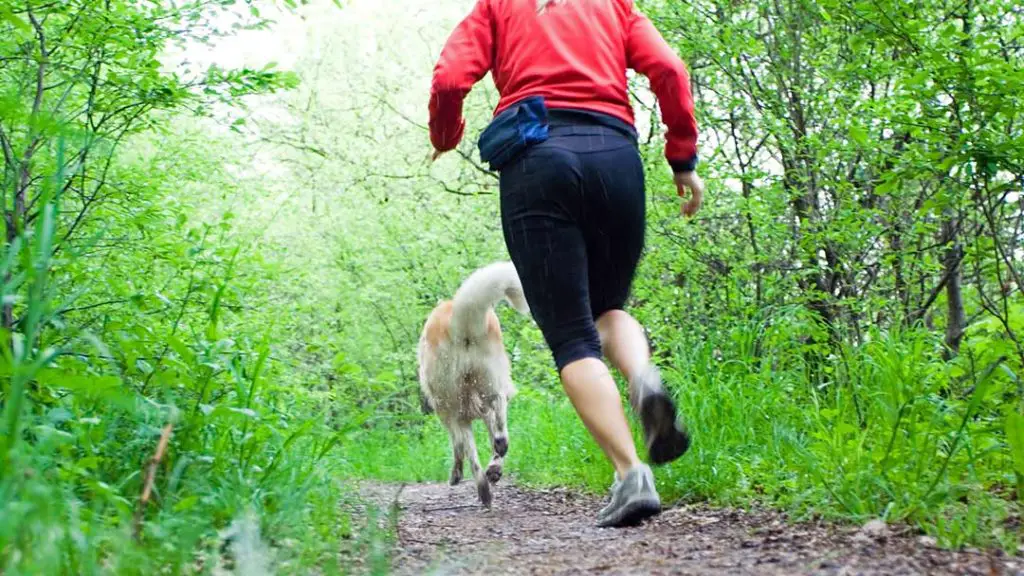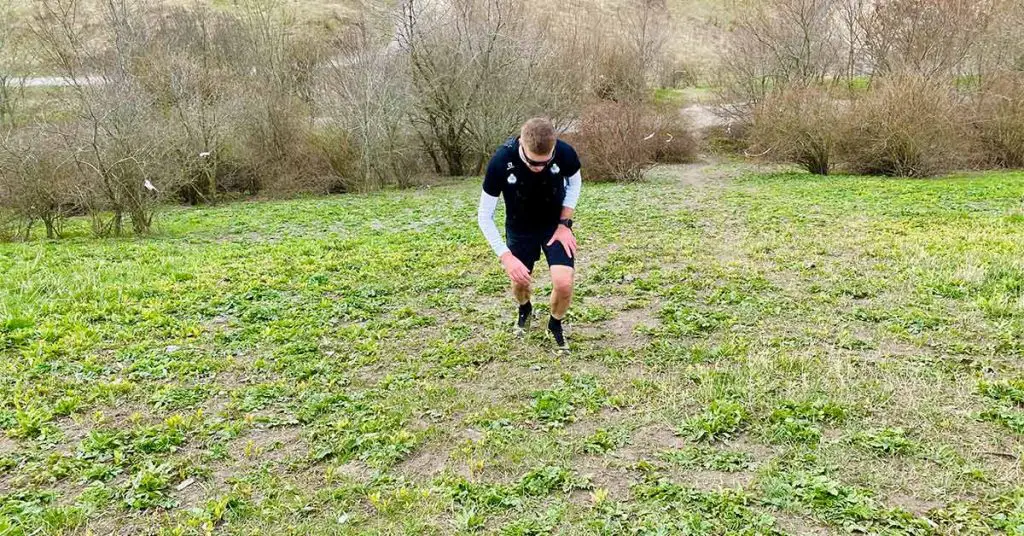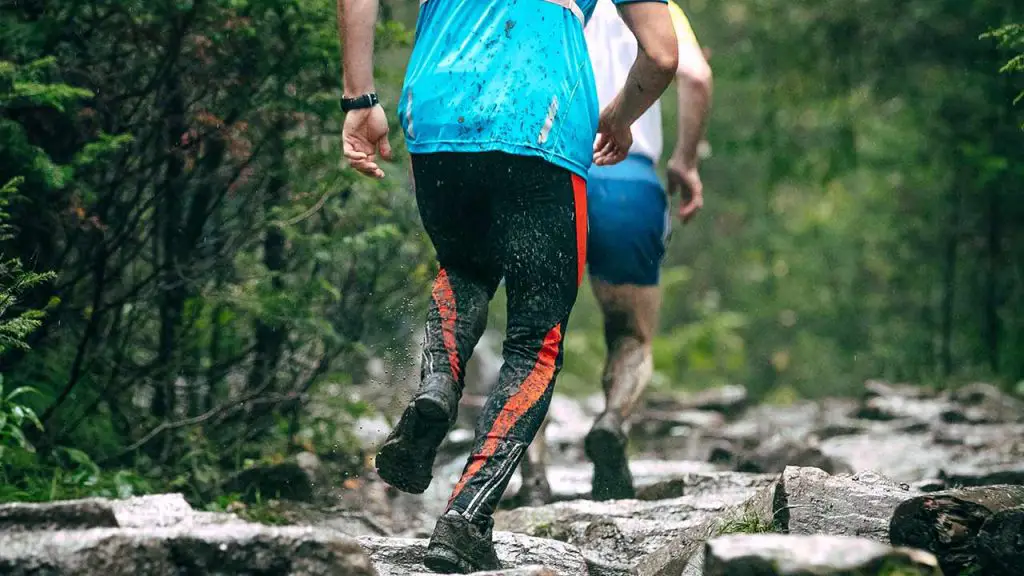Estimated read time: 11 minutes.
Do you love taking your dog on hikes and runs? If you do, did you know that you can take them trail running with you? Trail running can be a great way to get in some exercise with your pup and explore some new terrain. And trails provide the perfect setting for a fitness-focused outing with your furry friend.
It’s a fact that owning a dog is known to increase overall activity levels by an average of 300%. That’s because dogs make great workout partners – they motivate us to get up and move, whether it’s for a morning walk or an afternoon run. Just make sure to take the necessary safety precautions and prepare yourself and your dog for the challenge ahead.
Taking your dog for a run is a great way to get some exercise and bonding time with your furry friend. But before you hit the trail, there are a few things you should keep in mind. First, make sure your dog is well-trained and will obey commands such as “heel” and “stay.”
You’ll also want to start off slow, gradually working up to longer distances as your dog gets used to running. It’s important to bring plenty of water for both of you, and avoid running in hot weather. Lastly, be aware of other runners, hikers, and cyclists on the trail, and give them plenty of space.
Here are the reasons why trail running with your dog rocks! Keep reading for tips on how to get started with trail running with your dog!
Get Ready for a Trail Run With Your Dog
If you and your dog are both in good shape and enjoy spending time outdoors, then trail running is a great activity to do together.
However, there are a few things you should keep in mind before hitting the trails.
Water Container
Most people think that taking their dog for a run is a simple task- just put on their leash and off they go. First, make sure to bring plenty of water for both you and your dog, as it is important to stay hydrated during exercise. In addition to making sure that they have a good running route, they also need to make sure that their dog has enough water.
This can be tricky, since most dogs will not drink from a standard water bottle. That’s why many runners have turned to using water containers specifically designed for dogs. These containers typically have a nozzle that allows dogs to drink without stopping, making it easy to keep them hydrated during a run. If you’re looking for an easy way to keep your dog hydrated on runs, then a water container may be the perfect solution.
Dog Harness
Harnesses are typically comfortable. However, it must be an attachment that can easily and effectively protect the dog’s behavior. You also require an attached collar to be attached to your collar and/or leash.
Leash
The leash provides more control when it comes to a tricky situation. The leash is an excellent choice. It is safer as compared with the handheld version and is more compact. Certain leashes can be changed from handheld or strapped.
First Aid Kit
You should also bring a first-aid kit in case of any accidents.
Poop Bags
Picking up your dog’s treasures is the rule, so take waste bags with you to pick up dog treasures.
Trail Rules and Etiquette for Dogs
Taking your dog out on the trail with you can be a great way to bond and explore the great outdoors together. Generally, dogs are banned from entering national parks Many national forest areas and state and local parks permit leashes on their trails, although regulations are different.
When dogs can be taken off leash, we recommend using them anyway. Suddenly hazards may arise, animal chase is a temptation, and some users might have dogs on the lookout for them. A properly trained dog promotes open paths.
However, there are a few things to keep in mind in order to make sure that your experience is safe and enjoyable for both of you.
Always Use a Collar
First, always make sure that your dog is wearing a collar with ID tags in case they become separated from you.
Using the Leash
It’s also important to keep them on a leash at all times, as this will help to prevent them from getting lost or running into danger.
Selection of Trail
When choosing a trail, opt for one that is relatively flat and not too crowded. This will make it easier for your dog to stay with you and will reduce the risk of them becoming over-excited or overwhelmed.
Trail Hazards for Dogs
Though spending time on the trails with your dog can be a great way to bond and explore the great outdoors together, it’s important to be aware of the potential hazards that both you and your pup may encounter.
From poisonous plants to wildlife encounters, there are a number of risks that exist in even well-traveled areas. Keep an eye out for these common trail hazards when exploring with your dog, and be sure to take proper precautions to keep both of you safe.
Wild Plants
One of the most common dangers faced by dogs on the trails is exposure to poisonous plants. Many plants that are safe for humans can be harmful or even deadly to dogs if ingested, so it’s important to do your research before hitting the trail.
Be sure to check for any potentially dangerous plants in the area, and keep your dog on a leash to prevent them from getting too close. If you suspect that your dog has come into contact with a poisonous plant, seek professional medical help immediately.
Wildlife Encounters
Another hazard that dogs may face on the trail is encountering wildlife. Though most animals will avoid contact with humans and their dogs if given the chance, there are some exceptions – coyotes, and bears, for example, have been known to attack leashed dogs if they feel threatened. Dogs can sometimes stir up snakes or other animals that might otherwise stay hidden.
To reduce the risk of an encounter, make sure to keep your dog close by and always be aware of your surroundings. If you do see an animal while out on the trail, do not try to approach it – instead, make noise (yelling or using a whistle) to scare it away.
Waterborne Pathogens
One of the most important things is to be aware of waterborne pathogens. These are bacteria, viruses, and parasites that can be found in water sources such as lakes, rivers, and puddles.
While most of these pathogens are harmless to humans, they can cause serious illness in dogs. Symptoms include vomiting, diarrhea, and fever, and in some cases, they can even be fatal. So before you let your dog splash around in that muddy puddle, take a moment to consider the risks.
Be Aware of Sharp Object
Another hazard to be aware of on the trail is sharp objects such as sticks and thorns. These can easily puncture your dog’s skin, leading to infection or other injuries. It’s always a good idea to carry a first-aid kit when hiking with your dog, just in case.
Don’t Overheat Your Dog
Dogs are susceptible to heat stroke and over-heating, just like humans. Fur for dogs offers a great insulation system for the winter, but hot weather can lead to excessive heat loss. Usually, dogs don’t complain when heatstroke happens, but sometimes heatstroke is caused by temperatures as low as 71 degrees. The owner is responsible for avoiding the possibility that the dogs will overheat.
In hot weather, dogs can easily overheat, and without proper precautions, this can lead to heat stroke.
Symptoms of Heat Stroke
Some symptoms of heat stroke in dogs include excessive panting, drooling, weakness, and collapse.
Precautions to Prevent Over-Heat
If you suspect your dog has a heat stroke, it’s important to act quickly. Move them to a cool area and offer them water.
If they are not responding to treatment, or if their condition worsens, take them to the vet immediately.
With proper care, most dogs will recover from heat stroke without any lasting effects. However, it can be a serious condition, so it’s important to be vigilant when running in hot weather starts.
How to Know When Your Dog Is Tired on a Run?
Going for a trail running with your dog can be a great way to get some exercise, but it’s important to make sure that your dog doesn’t get too tired. It will also show you how quickly the dog starts getting tired when running together and how well they behave in your presence.
Similar to human behavior, individuals show the same signs in different ways, although common clear signs if a dog shows that they’ve become tired can be combined.
So how can you tell when your dog is starting to tire out? There are a few key signs to look for.
Breathing Problem
Your dog run will start to slow down. If they were running at a steady pace before, they will now likely be lagging behind or taking more frequent breaks. Their tongue will begin to hang out of their mouth, and they will start to pant more heavily. This is their way of cooling down and indicates that they are working harder than usual.
Starts Running Slightly Behind Us
Finally, you may notice that their energy level (dog’s stamina) drops, and they seem less enthusiastic about running. If you see any of these signs, it’s time to call it a day and head home.
Dog First Aid When Trail Running and Hiking
For dog owners who enjoy spending time outdoors with their furry friends, it’s important to be prepared for any eventuality. While most dogs are relatively low-maintenance pets, they can still suffer from health problems while on the trail. Here are a few tips for giving your dog first aid when you’re miles from civilization.
Dehydration
One of the most common issues that dogs face while hiking is dehydration. Dogs don’t sweat as humans do, so they can become overheated quickly if they don’t have enough water.
Be sure to pack enough water for both you and your dog, and take frequent breaks to give your dog a drink. If you notice that your dog is panting excessively or seems lethargic, these are signs of heat stroke, and you should seek medical help immediately.
Paw Injuries
The other common issue is paw injuries. Rocks, thorny plants, and hot pavement can all damage your dog’s paws. Be sure to inspect your dog’s paws regularly, and look for any cuts or abrasions.
If you find any injuries, clean them with soap and water and apply a bandage if necessary. You should also carry a pair of tweezers in case your dog steps on a foreign object such as a piece of glass or metal.
Encountering Other Trail Users When Running With Your Dog
When you take your dog for a run on the trails, you’re likely to encounter other users, including hikers, bikers, and other dog walkers. While most people are friendly and respectful, it’s important to be aware of trail etiquette to ensure that everyone has a safe and enjoyable experience.
When passing others on the trail, be sure to give them plenty of space, and if your dog is particularly rambunctious, consider keeping them on a leash. If you’re running in a group, try to stick to a single file so that other users can easily pass. And finally, be sure to clean up after your pet, both on and off the trail.
Other Useful Dogs Running Gear for Trail Running
If you’re planning on hitting the trails with your furry friend, there are a few things you’ll need to pick up before you go.
Good Quality Leash and Collar
Invest in a good quality leash and collar that will be comfortable for your dog and other dogs and won’t rub their fur the wrong way. You’ll also want to get a harness specifically designed for running, which will distribute their weight more evenly and make it easier for you to control them on the trail.
Goggles
To protect your eyes from snow and water reflections, dust, and dirt, carry your goggles with you.
Energy Snacks
Finally, don’t forget to pack some high-energy snacks for your pup – they’ll be working hard and burning lots of calories!
With all the right gear, you and your dog will be ready to take on any trail.
Caring for Your Dog After a Trail Run
After a long day of hiking or running, your dog may be tired and dirty. Here are some tips for caring for your dog after a trail run:
Have Him Relax in a Shady Spot
Give your dog a chance to cool down before starting the grooming process. If your dog is panting heavily, offer them some water and let them rest in a shady spot for a few minutes. Once they’ve cooled down, you can start to brush out any dirt, mud, or debris that may be clinging to their fur.
Cleaning of Paws
If your dog paws are muddy or covered in debris, you’ll need to clean dog’s body and dry them off before continuing. Mud can cause irritation and discomfort, so it’s important to make sure their paws are clean.
To clean their paws, simply wipe them off with a damp cloth or use a gentle paw cleaning solution. Once they’re clean, dry their paws thoroughly before letting them walk on carpet or furniture.
Bath-Time After a Run With Your Dog
Give your dog a good all-over rinse with fresh water. Use a hose or bucket to wet their fur completely, and then apply a mild pet shampoo. Work the shampoo into their fur and rinse thoroughly until the water runs clear.
Finally, towels dry your dog and give them a good rubdown to help remove any remaining dirt or residue.
By following these simple steps, you can help keep your trail Dog happy and healthy after spending time outdoors!
Conclusion
Trail running with your dog can be a great way to bond and explore the outdoors together. However, it’s important to be prepared before hitting the trails. Make sure you have the proper gear for your dog, and take some time to train them on how to behave on the trail. With a little preparation, you and your dog can enjoy many happy hours trail running together!
FAQ’s
How do you train a dog to trail run with you?
Most dogs love to run, and many are natural athletes that excel at endurance activities like trail running. However, even the most enthusiastic dog will need some training before hitting the trails with you. The first step is to gradually increase the distance and intensity of your runs together.
Start with short jogs around the block, then work up to longer distances at a relatively easy pace. Once you’ve built up a basic level of fitness, you can begin to introduce more challenging trails, hills, and other obstacles.
Is trail running good for dogs?
For anyone who loves hiking, trail running is an excellent aerobic workout that should become part of a daily routine. It’s great to run with the dog.
Is it cruel to run with dogs?
Running longer distances is a highly impactful, cardiovascular-intensive exercise that can cause serious injuries if your puppies are not properly trained. Joint problems, including arthritic arthritis, apnea, or luxation patellas, can be dangerous to the body.
What you need to know before you go trail running with your dog?
If you’re already an avid trail runner, then you might need some advice and basic commands before taking your dog with you for a trail run.
- How Many Laps Around a Track is a 5K: Your Guide - October 22, 2023
- When is Track and Field Season? - October 22, 2023
- Understanding the Length: How Long Is a Running Track? - October 22, 2023



